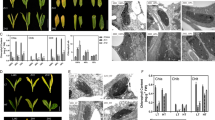Abstract
Chrysanthemum is one of the most important commercial cut flowers in the world. Early-flowering cultivars are required to produce quality chrysanthemum flowers with a lower cost of production. To shorten the vegetative growth phase of chrysanthemum, three AP1-like genes from Asteraceae were constitutively overexpressed in 80 independent transgenic chrysanthemum lines. All lines were characterized by PCR and RT-PCR and demonstrated that overexpression of compositae AP1-homologs in transgenic chrysanthemum under long-day conditions had no effect on plant development compared to non-transgenic controls. Conversely, under short-day conditions, transgenic plants commenced bud initiation 2 wk earlier than non-transgenic chrysanthemum plants. Subsequently, transgenic chrysanthemum flowers showed color earlier and resulted in full opening of inflorescences 3 wk prior to non-transgenic control plants. These results open new possibilities for genetic improvement and breeding of chrysanthemum cultivars.




Similar content being viewed by others
References
Amazino R. Seasonal and developmental timing of flowering. Plant J 61: 1001–1013; 2010.
Anderson N. O. Chrysanthemum (Dendranthema x grandiflora Tzvelv.). In: Anderson N. O. (ed) Flower breeding and genetics. Springer, Berlin, pp 389–437; 2007.
Blazquez M. A.; Ferrandiz C.; Madueno F.; Parcy F. How floral meristems are built. Plant Mol Biol 60: 855–870; 2006.
Chandler J.; Crobesier L.; Spielmann P.; Dettendorfer D.; Stahl D.; Apel K.; Melzer S. Modulating flowering time and prevention of pod shatter in oilseed rape. Mol Breed 15: 87–94; 2005.
Ellul P.; Angosto T.; Garcia-Sogo B.; Garcia-Hurtado N.; Martin-Trillo M.; Salinas M.; Moreno V.; Lozano R.; Martinez-Zapater J. M. Expression of Arabidopsis APETALA1 on tomato reduces its vegetative cycle without affecting plant production. Mol Breed 13: 155–163; 2004.
Goloveshkina E. N.; Shul’ga O. A.; Shchennikova A. V.; Kamionskaya A. M.; Skryabin K. G. Constitutive Expression of the Sunflower and Chrysanthemum Genes of the AP1/FUL Group Changes Flowering Timing in Transgenic Tobacco Plants. Dokl Biol Sci 434: 322–324; 2010.
Han B. H.; Lee S. Y.; Choi S. Y. MdMADS2 – transgenic chrysanthemum (Dendrathema grandiflorum (Ramat.) Kitamura) showing the reduction of the days to flowering. J Plant Biotechnol 36: 366–372; 2009.
He Z.; Zhu Q.; Dabi T.; Li D.; Weigel D.; Lamb C. Transformation of rice with the Arabidopsis floral regulator LEAFY causes early heading. Transgenic Res 9: 223–227; 2000.
Hofgen R.; Willmitzer L. Storage of competent cells for Agrobacterium transformation. Nucl Acids Res 16: 9877; 1988.
Immink R. G. H.; Gadella T. W. J.; Ferrario S.; Busscher M.; Angenent G. C. Analysis of MADS box protein-protein interactions in living plant cells. Proc Natl Acad Sci USA 99: 2416–2421; 2002.
Jang S.; An K.; Lee S.; An G. Characterization of tobacco MADS-box genes involved in floral initiation. Plant Cell Physiol 43: 230–238; 2002.
Jung C.; Müller A. Flowering time control and applications in plant breeding. Trends in Plant Sci 14: 563–573; 2009.
Koornneef M.; Alonso-Blanco A.; Peeters A. J. M.; Soppe W. Genetic control of flowering time in Arabidopsis. Annu Rev Plant Physiol 49: 345–370; 1998.
Kotoda N.; Wada M.; Masuda T.; Soejima J. The break-through in the reduction of juvenile phase in apple using transgenic approaches. Acta Hortic (ISHS) 625: 337–343; 2003.
Li T.; Niki T.; Nishijima T.; Douzono M.; Koshioka M.; Hisamatsu T. Roles of CmFL, CmAFL1, and CmSOC1 in the transition from vegetative to reproductive growth in Chrysanthemum morifolium Ramat. J Hort Sci Biotech 84: 447–453; 2009.
Litt A.; Irish V. F. Duplication and diversification in the APETALA1/FRUITFULL floral homeotic gene lineage: implications for the evolution of floral development. Genetics 165: 821–833; 2003.
Ma Y. P.; Fang X. H.; Chen F.; Dai S. L. DFL, a FLORICAULA/LEAFY homologue gene from Dendranthema lavandulifolium is expressed both in the vegetative and reproductive tissues. Plant Cell Rep 27: 647–654; 2008.
Mitiouchkina T.; Dolgov S. V.; Zavriev K.; Kharchenko P. N. Molecular biology approach for improving chrysanthemum resistance to virus B. Acta Hortic (ISHS) 722: 327–332; 2006.
Mouradov A.; Cremer F.; Coupland G. Control of flowering time: interacting pathways as a basis for diversity. Plant Cell 14: 111–130; 2002.
Murashige T.; Skoog F. A revised medium for rapid growth and bioassays with tobacco tissue cultures. Physiol Plant 15: 473–497; 1962.
Quoirin M.; Lepoivre P. Improved medium for in vitro culture of Prunus sp. Acta Hortic 78: 437–442; 1977.
Revenkova E. V.; Kraev A. S.; Skryabin K. G. Construction of a disarmed derivative of the supervirulent Ti plasmid pTiBo542. In: Skryabin K. G. (ed) Plant biotechnology and molecular biology. Pushchino Research Centre, Moscow, pp 67–76; 1993.
Shchennikova A. V.; Shulga O. A.; Immink R.; Skryabin K. G.; Angenent G. C. Identification and characterization of four chrysanthemum MADS-box genes, belonging to the APETALA1/FRUITFULL and SEPALLATA3 subfamilies. Plant Physiol 134: 1632–1641; 2004.
Shulga O. A.; Shchennikova A. V.; Angenent G. C.; Skryabin K. G. MADS-box genes controlling inflorescence morphogenesis in sunflower. Russian J Dev Biol 39: 2–5; 2008.
van Engelen F. A.; Molthoff J. W.; Conner A. J.; Nap J.; Pereira A.; Stiekema W. J. pBINPLUS: an improved plant transformation vector based on pBIN19. Transgenic Res 4: 288–290; 1995.
Yu D.; Kotilainen M.; Pöllänen E.; Mehto M.; Elomaa P.; Helariutta Y.; Albert V. A.; Teeri T. H. Organ identity genes and modified patterns of flower development in Gerbera hybrida (Asteraceae). Plant J 17: 51–62; 1999.
Yu H.; Goh C. J. Identification and characterization of three orchid MADS-box genes of the AP1/AGL9 subfamily during floral transition. J Plant Physiol 123: 1325–1336; 2000.
Weigel D.; Nilsson O. A developmental switch sufficient for flower initiation in diverse plants. Nature 377: 495–500; 1995.
Author information
Authors and Affiliations
Corresponding author
Additional information
Editor: N. J. Taylor
Rights and permissions
About this article
Cite this article
Shulga, O.A., Mitiouchkina, T.Y., Shchennikova, A.V. et al. Overexpression of AP1-like genes from Asteraceae induces early-flowering in transgenic Chrysanthemum plants. In Vitro Cell.Dev.Biol.-Plant 47, 553–560 (2011). https://doi.org/10.1007/s11627-011-9393-0
Received:
Accepted:
Published:
Issue Date:
DOI: https://doi.org/10.1007/s11627-011-9393-0




